Egypt Tourism: Historical Overview, Destination Attractiveness, and Tourism Policies
VerifiedAdded on 2022/10/02
|11
|3225
|113
AI Summary
This report explores the historical overview of tourism development in Egypt, its international tourism visitation, destination attractiveness, host community impacts of tourism, destination development issue analysis, and tourism policy issue analysis.
Contribute Materials
Your contribution can guide someone’s learning journey. Share your
documents today.
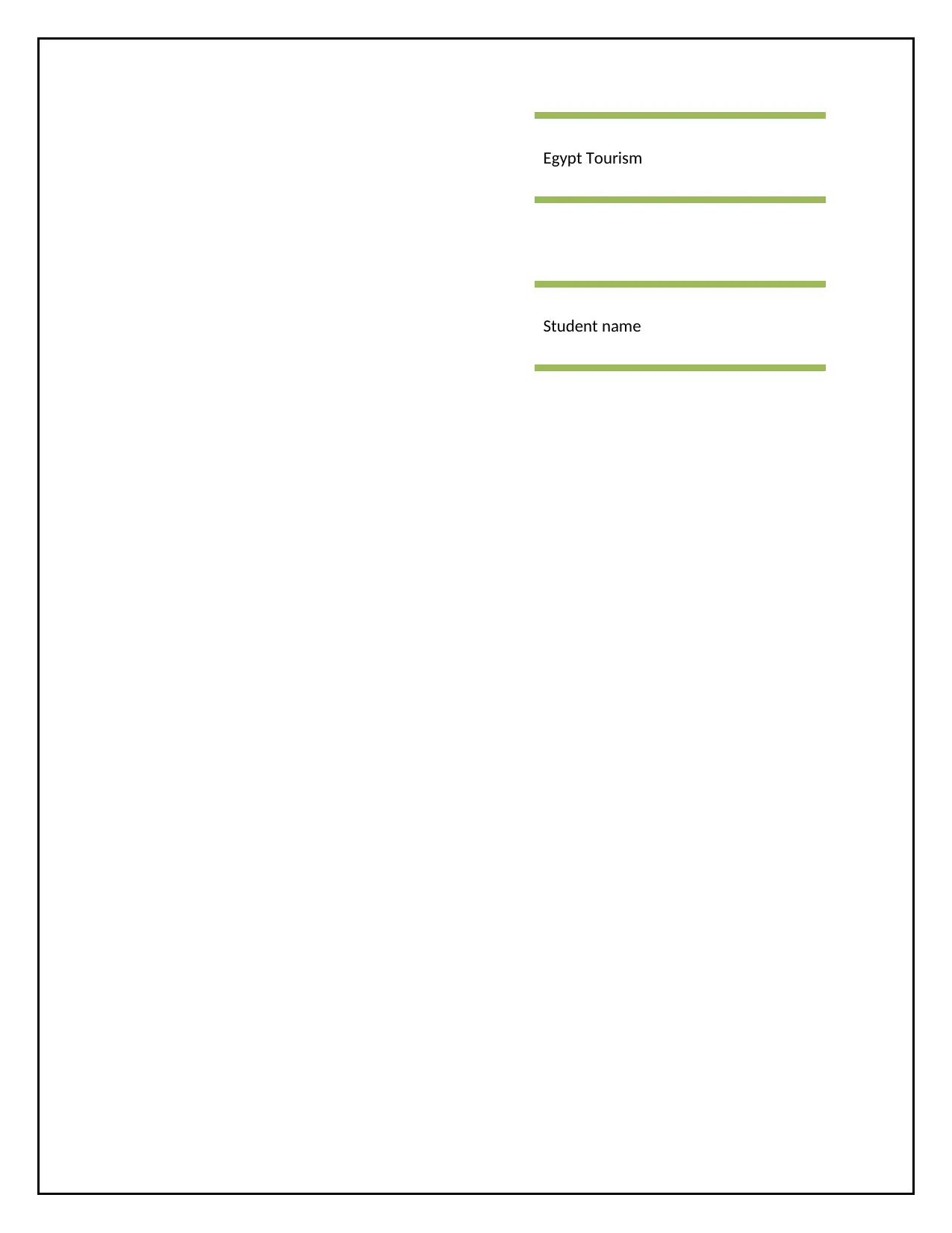
Egypt Tourism
Student name
Student name
Secure Best Marks with AI Grader
Need help grading? Try our AI Grader for instant feedback on your assignments.
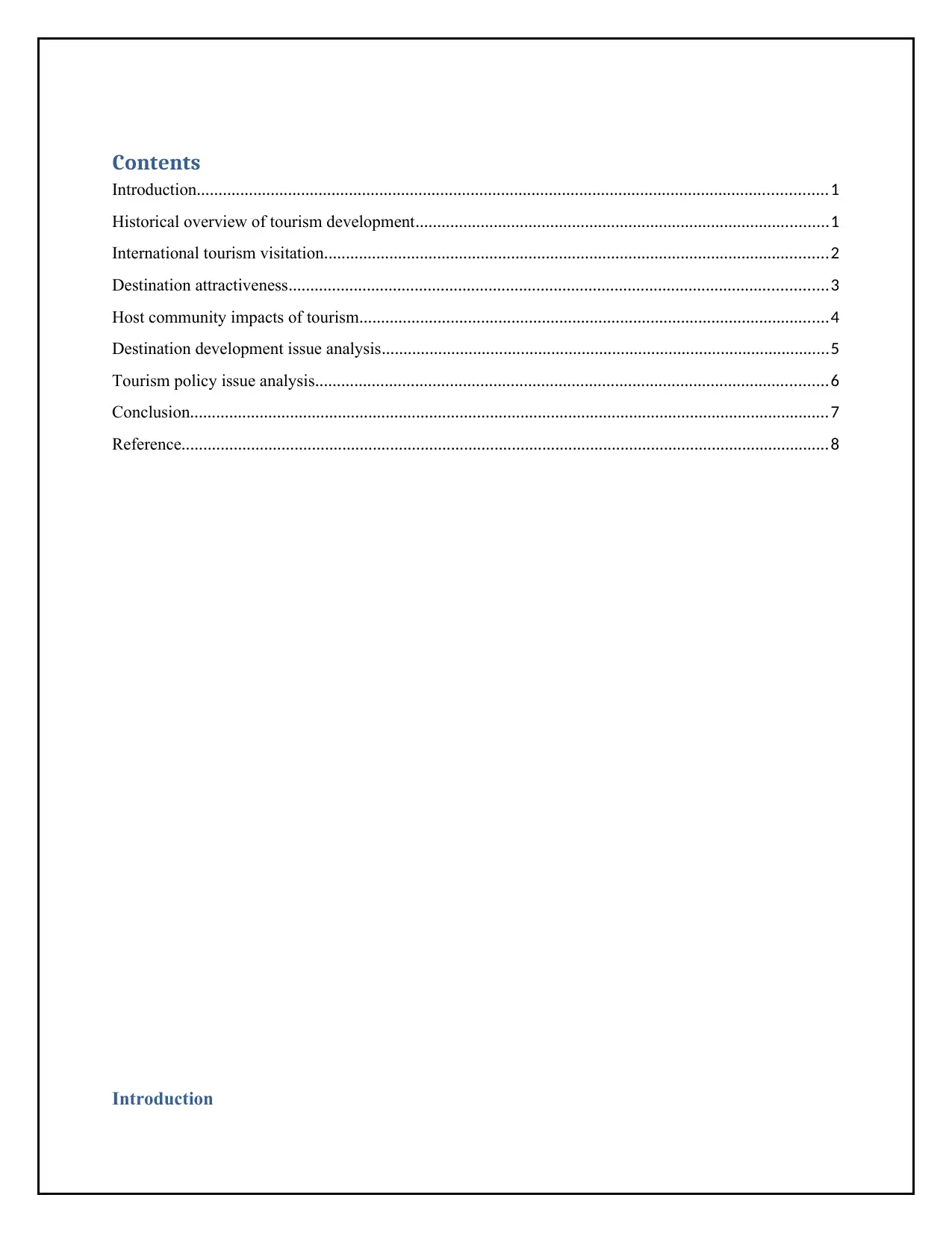
Contents
Introduction.................................................................................................................................................1
Historical overview of tourism development...............................................................................................1
International tourism visitation....................................................................................................................2
Destination attractiveness............................................................................................................................3
Host community impacts of tourism............................................................................................................4
Destination development issue analysis.......................................................................................................5
Tourism policy issue analysis......................................................................................................................6
Conclusion...................................................................................................................................................7
Reference.....................................................................................................................................................8
Introduction
Introduction.................................................................................................................................................1
Historical overview of tourism development...............................................................................................1
International tourism visitation....................................................................................................................2
Destination attractiveness............................................................................................................................3
Host community impacts of tourism............................................................................................................4
Destination development issue analysis.......................................................................................................5
Tourism policy issue analysis......................................................................................................................6
Conclusion...................................................................................................................................................7
Reference.....................................................................................................................................................8
Introduction
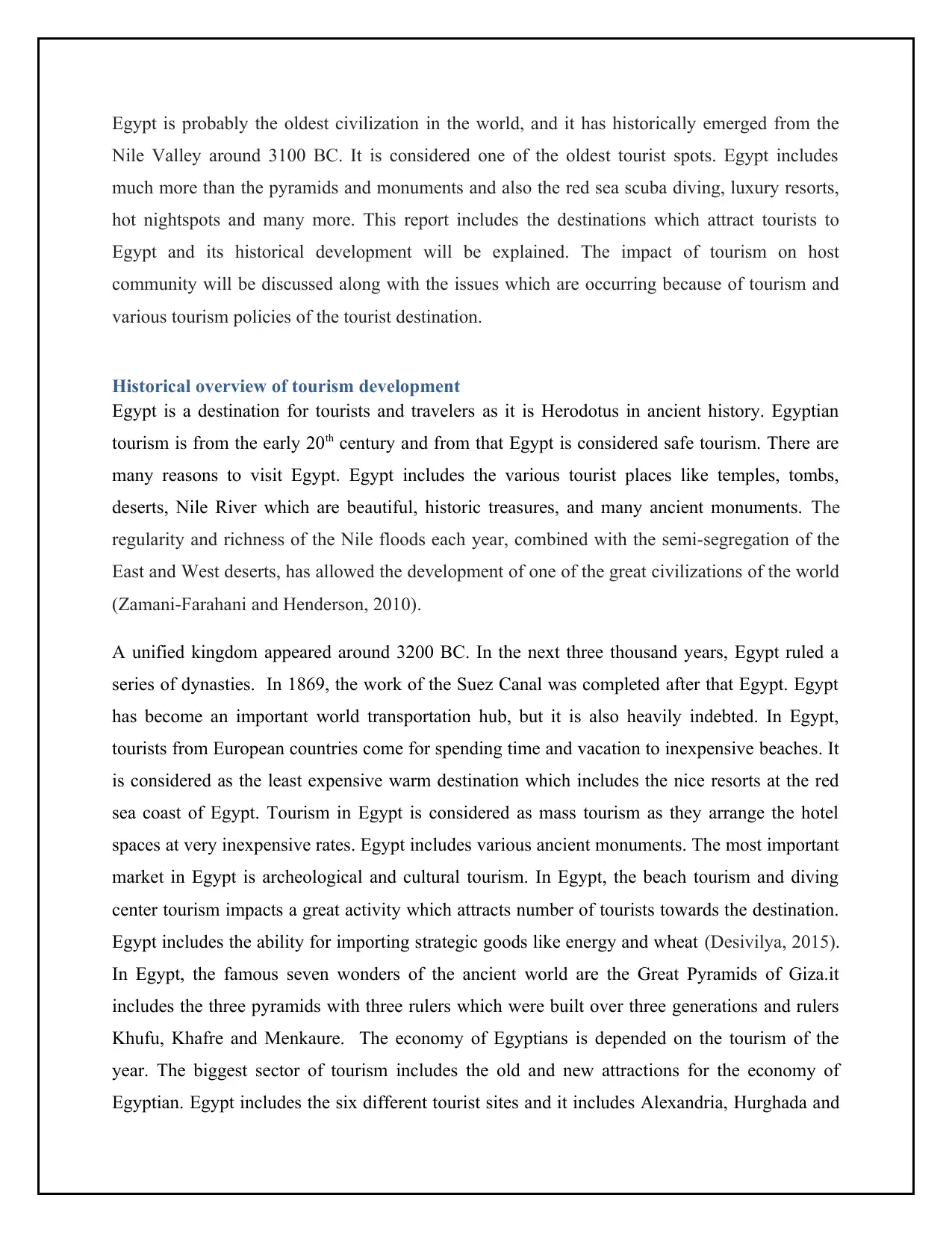
Egypt is probably the oldest civilization in the world, and it has historically emerged from the
Nile Valley around 3100 BC. It is considered one of the oldest tourist spots. Egypt includes
much more than the pyramids and monuments and also the red sea scuba diving, luxury resorts,
hot nightspots and many more. This report includes the destinations which attract tourists to
Egypt and its historical development will be explained. The impact of tourism on host
community will be discussed along with the issues which are occurring because of tourism and
various tourism policies of the tourist destination.
Historical overview of tourism development
Egypt is a destination for tourists and travelers as it is Herodotus in ancient history. Egyptian
tourism is from the early 20th century and from that Egypt is considered safe tourism. There are
many reasons to visit Egypt. Egypt includes the various tourist places like temples, tombs,
deserts, Nile River which are beautiful, historic treasures, and many ancient monuments. The
regularity and richness of the Nile floods each year, combined with the semi-segregation of the
East and West deserts, has allowed the development of one of the great civilizations of the world
(Zamani Farahani and Henderson, 2010)‐ .
A unified kingdom appeared around 3200 BC. In the next three thousand years, Egypt ruled a
series of dynasties. In 1869, the work of the Suez Canal was completed after that Egypt. Egypt
has become an important world transportation hub, but it is also heavily indebted. In Egypt,
tourists from European countries come for spending time and vacation to inexpensive beaches. It
is considered as the least expensive warm destination which includes the nice resorts at the red
sea coast of Egypt. Tourism in Egypt is considered as mass tourism as they arrange the hotel
spaces at very inexpensive rates. Egypt includes various ancient monuments. The most important
market in Egypt is archeological and cultural tourism. In Egypt, the beach tourism and diving
center tourism impacts a great activity which attracts number of tourists towards the destination.
Egypt includes the ability for importing strategic goods like energy and wheat (Desivilya, 2015).
In Egypt, the famous seven wonders of the ancient world are the Great Pyramids of Giza.it
includes the three pyramids with three rulers which were built over three generations and rulers
Khufu, Khafre and Menkaure. The economy of Egyptians is depended on the tourism of the
year. The biggest sector of tourism includes the old and new attractions for the economy of
Egyptian. Egypt includes the six different tourist sites and it includes Alexandria, Hurghada and
Nile Valley around 3100 BC. It is considered one of the oldest tourist spots. Egypt includes
much more than the pyramids and monuments and also the red sea scuba diving, luxury resorts,
hot nightspots and many more. This report includes the destinations which attract tourists to
Egypt and its historical development will be explained. The impact of tourism on host
community will be discussed along with the issues which are occurring because of tourism and
various tourism policies of the tourist destination.
Historical overview of tourism development
Egypt is a destination for tourists and travelers as it is Herodotus in ancient history. Egyptian
tourism is from the early 20th century and from that Egypt is considered safe tourism. There are
many reasons to visit Egypt. Egypt includes the various tourist places like temples, tombs,
deserts, Nile River which are beautiful, historic treasures, and many ancient monuments. The
regularity and richness of the Nile floods each year, combined with the semi-segregation of the
East and West deserts, has allowed the development of one of the great civilizations of the world
(Zamani Farahani and Henderson, 2010)‐ .
A unified kingdom appeared around 3200 BC. In the next three thousand years, Egypt ruled a
series of dynasties. In 1869, the work of the Suez Canal was completed after that Egypt. Egypt
has become an important world transportation hub, but it is also heavily indebted. In Egypt,
tourists from European countries come for spending time and vacation to inexpensive beaches. It
is considered as the least expensive warm destination which includes the nice resorts at the red
sea coast of Egypt. Tourism in Egypt is considered as mass tourism as they arrange the hotel
spaces at very inexpensive rates. Egypt includes various ancient monuments. The most important
market in Egypt is archeological and cultural tourism. In Egypt, the beach tourism and diving
center tourism impacts a great activity which attracts number of tourists towards the destination.
Egypt includes the ability for importing strategic goods like energy and wheat (Desivilya, 2015).
In Egypt, the famous seven wonders of the ancient world are the Great Pyramids of Giza.it
includes the three pyramids with three rulers which were built over three generations and rulers
Khufu, Khafre and Menkaure. The economy of Egyptians is depended on the tourism of the
year. The biggest sector of tourism includes the old and new attractions for the economy of
Egyptian. Egypt includes the six different tourist sites and it includes Alexandria, Hurghada and
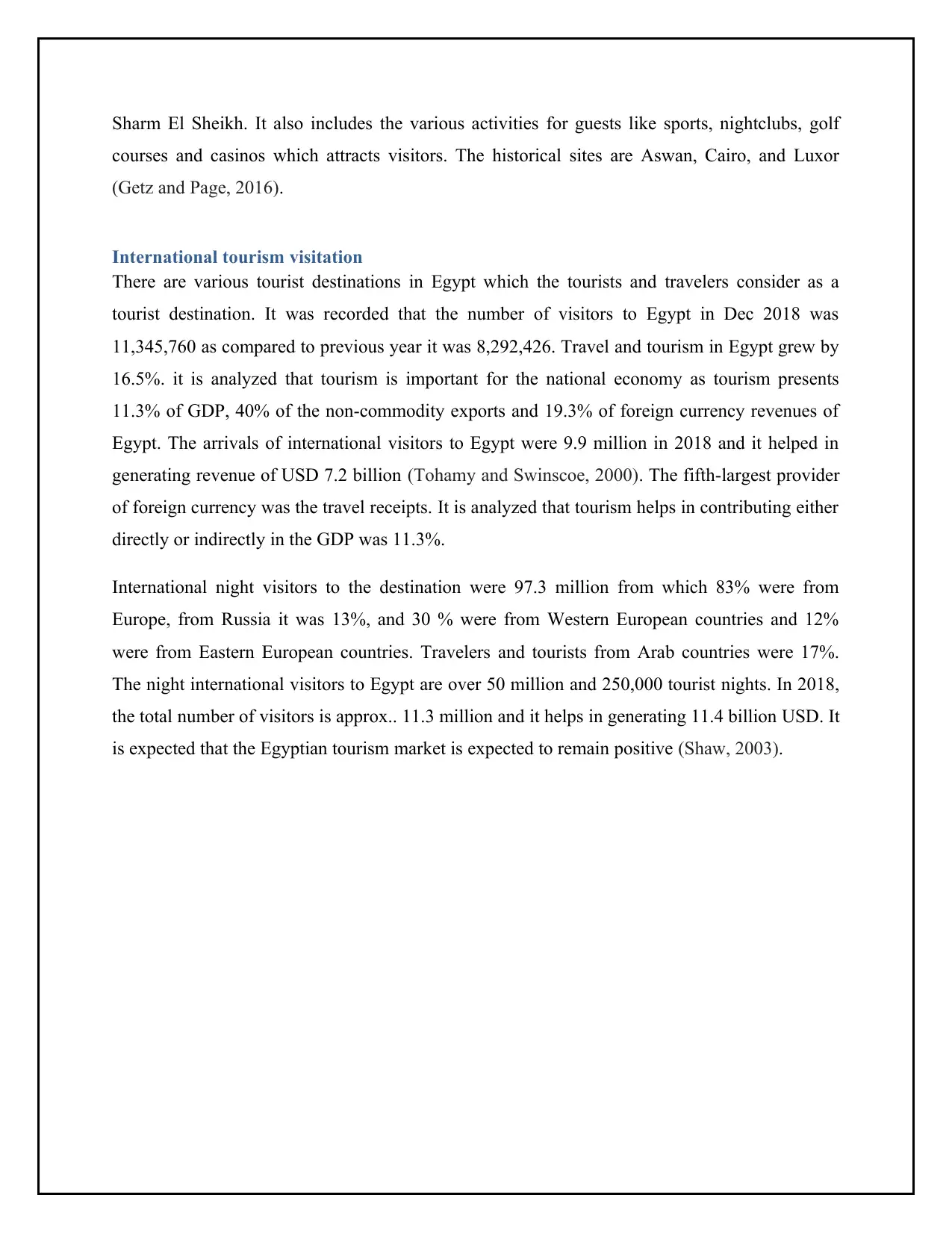
Sharm El Sheikh. It also includes the various activities for guests like sports, nightclubs, golf
courses and casinos which attracts visitors. The historical sites are Aswan, Cairo, and Luxor
(Getz and Page, 2016).
International tourism visitation
There are various tourist destinations in Egypt which the tourists and travelers consider as a
tourist destination. It was recorded that the number of visitors to Egypt in Dec 2018 was
11,345,760 as compared to previous year it was 8,292,426. Travel and tourism in Egypt grew by
16.5%. it is analyzed that tourism is important for the national economy as tourism presents
11.3% of GDP, 40% of the non-commodity exports and 19.3% of foreign currency revenues of
Egypt. The arrivals of international visitors to Egypt were 9.9 million in 2018 and it helped in
generating revenue of USD 7.2 billion (Tohamy and Swinscoe, 2000). The fifth-largest provider
of foreign currency was the travel receipts. It is analyzed that tourism helps in contributing either
directly or indirectly in the GDP was 11.3%.
International night visitors to the destination were 97.3 million from which 83% were from
Europe, from Russia it was 13%, and 30 % were from Western European countries and 12%
were from Eastern European countries. Travelers and tourists from Arab countries were 17%.
The night international visitors to Egypt are over 50 million and 250,000 tourist nights. In 2018,
the total number of visitors is approx.. 11.3 million and it helps in generating 11.4 billion USD. It
is expected that the Egyptian tourism market is expected to remain positive (Shaw, 2003).
courses and casinos which attracts visitors. The historical sites are Aswan, Cairo, and Luxor
(Getz and Page, 2016).
International tourism visitation
There are various tourist destinations in Egypt which the tourists and travelers consider as a
tourist destination. It was recorded that the number of visitors to Egypt in Dec 2018 was
11,345,760 as compared to previous year it was 8,292,426. Travel and tourism in Egypt grew by
16.5%. it is analyzed that tourism is important for the national economy as tourism presents
11.3% of GDP, 40% of the non-commodity exports and 19.3% of foreign currency revenues of
Egypt. The arrivals of international visitors to Egypt were 9.9 million in 2018 and it helped in
generating revenue of USD 7.2 billion (Tohamy and Swinscoe, 2000). The fifth-largest provider
of foreign currency was the travel receipts. It is analyzed that tourism helps in contributing either
directly or indirectly in the GDP was 11.3%.
International night visitors to the destination were 97.3 million from which 83% were from
Europe, from Russia it was 13%, and 30 % were from Western European countries and 12%
were from Eastern European countries. Travelers and tourists from Arab countries were 17%.
The night international visitors to Egypt are over 50 million and 250,000 tourist nights. In 2018,
the total number of visitors is approx.. 11.3 million and it helps in generating 11.4 billion USD. It
is expected that the Egyptian tourism market is expected to remain positive (Shaw, 2003).
Secure Best Marks with AI Grader
Need help grading? Try our AI Grader for instant feedback on your assignments.
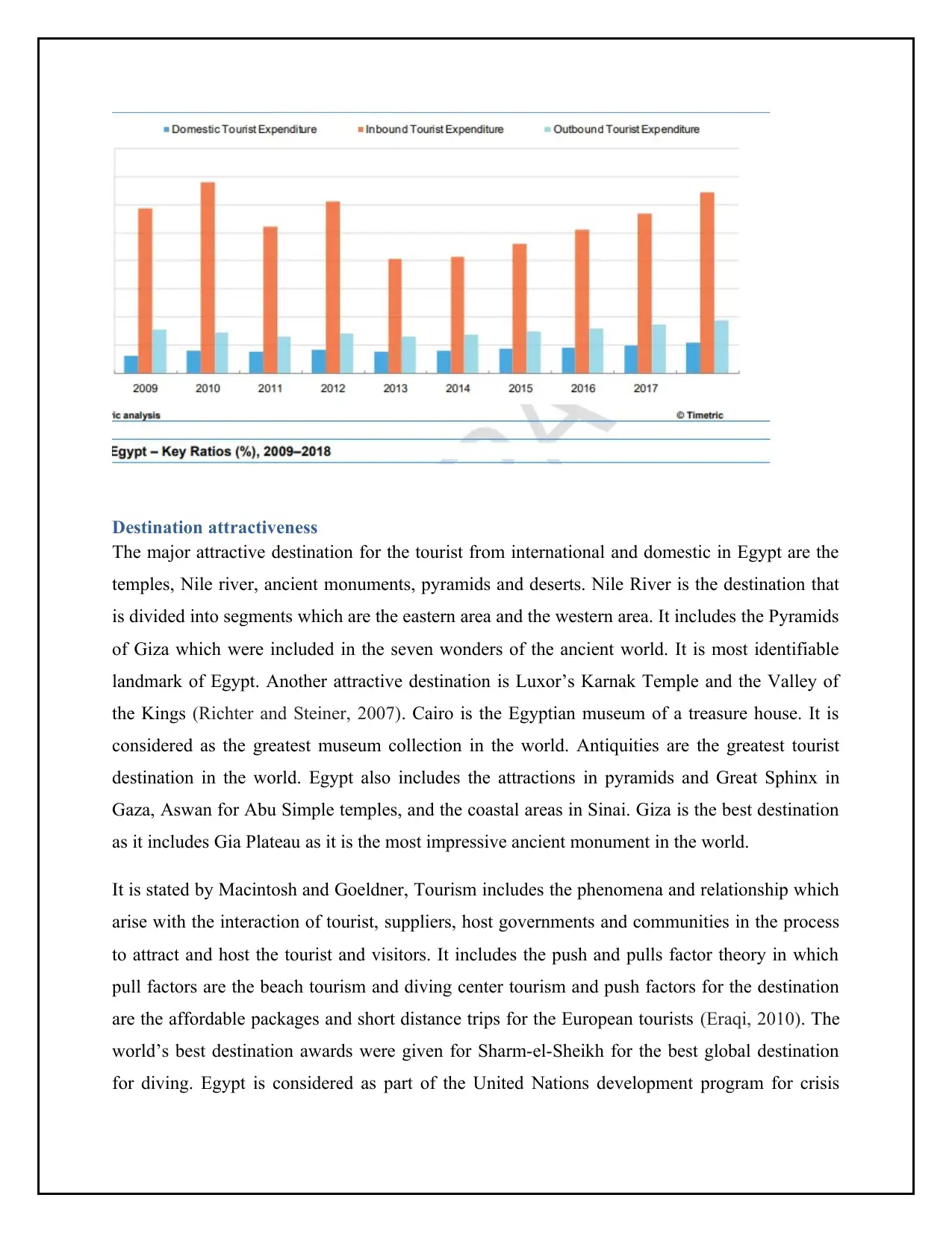
Destination attractiveness
The major attractive destination for the tourist from international and domestic in Egypt are the
temples, Nile river, ancient monuments, pyramids and deserts. Nile River is the destination that
is divided into segments which are the eastern area and the western area. It includes the Pyramids
of Giza which were included in the seven wonders of the ancient world. It is most identifiable
landmark of Egypt. Another attractive destination is Luxor’s Karnak Temple and the Valley of
the Kings (Richter and Steiner, 2007). Cairo is the Egyptian museum of a treasure house. It is
considered as the greatest museum collection in the world. Antiquities are the greatest tourist
destination in the world. Egypt also includes the attractions in pyramids and Great Sphinx in
Gaza, Aswan for Abu Simple temples, and the coastal areas in Sinai. Giza is the best destination
as it includes Gia Plateau as it is the most impressive ancient monument in the world.
It is stated by Macintosh and Goeldner, Tourism includes the phenomena and relationship which
arise with the interaction of tourist, suppliers, host governments and communities in the process
to attract and host the tourist and visitors. It includes the push and pulls factor theory in which
pull factors are the beach tourism and diving center tourism and push factors for the destination
are the affordable packages and short distance trips for the European tourists (Eraqi, 2010). The
world’s best destination awards were given for Sharm-el-Sheikh for the best global destination
for diving. Egypt is considered as part of the United Nations development program for crisis
The major attractive destination for the tourist from international and domestic in Egypt are the
temples, Nile river, ancient monuments, pyramids and deserts. Nile River is the destination that
is divided into segments which are the eastern area and the western area. It includes the Pyramids
of Giza which were included in the seven wonders of the ancient world. It is most identifiable
landmark of Egypt. Another attractive destination is Luxor’s Karnak Temple and the Valley of
the Kings (Richter and Steiner, 2007). Cairo is the Egyptian museum of a treasure house. It is
considered as the greatest museum collection in the world. Antiquities are the greatest tourist
destination in the world. Egypt also includes the attractions in pyramids and Great Sphinx in
Gaza, Aswan for Abu Simple temples, and the coastal areas in Sinai. Giza is the best destination
as it includes Gia Plateau as it is the most impressive ancient monument in the world.
It is stated by Macintosh and Goeldner, Tourism includes the phenomena and relationship which
arise with the interaction of tourist, suppliers, host governments and communities in the process
to attract and host the tourist and visitors. It includes the push and pulls factor theory in which
pull factors are the beach tourism and diving center tourism and push factors for the destination
are the affordable packages and short distance trips for the European tourists (Eraqi, 2010). The
world’s best destination awards were given for Sharm-el-Sheikh for the best global destination
for diving. Egypt is considered as part of the United Nations development program for crisis
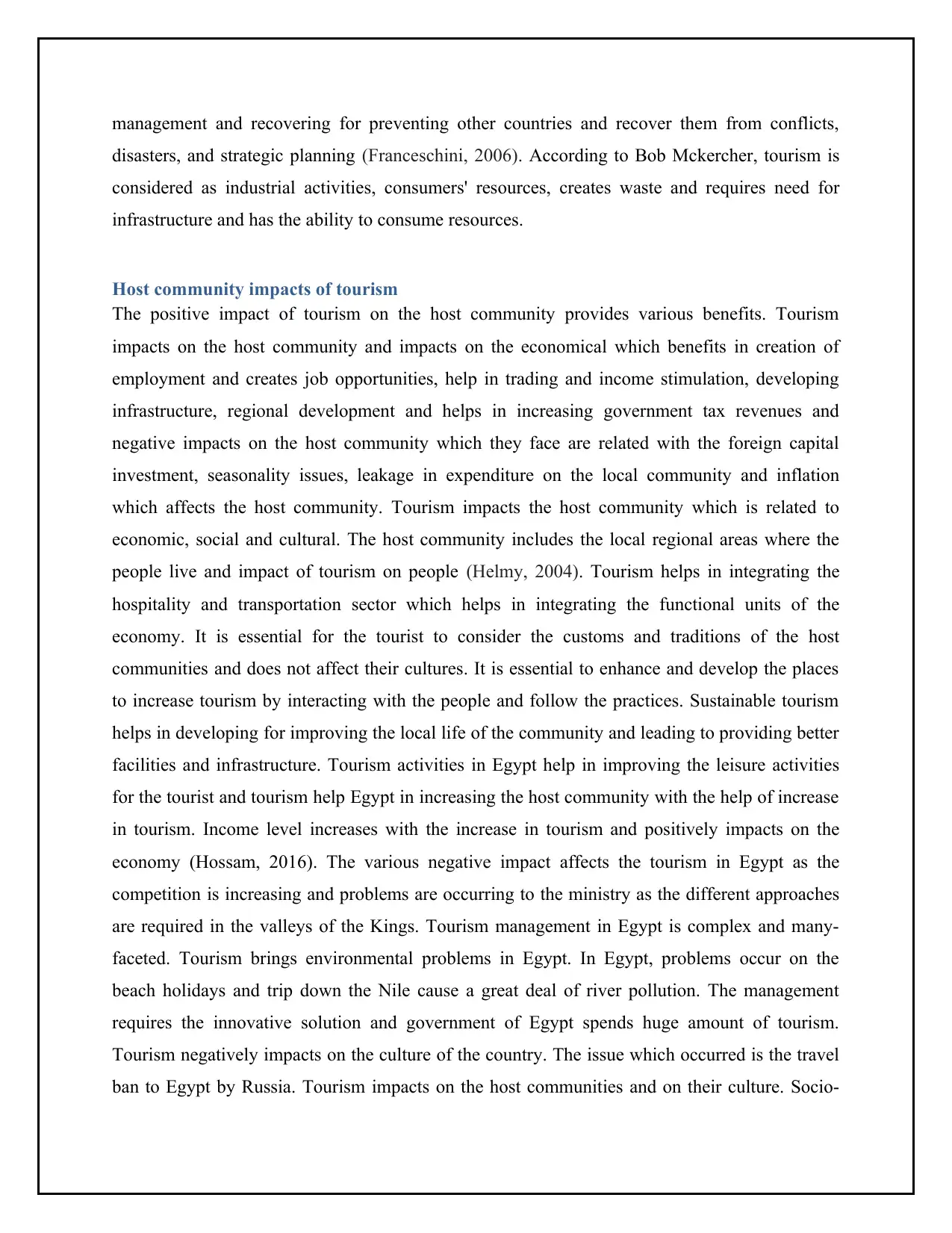
management and recovering for preventing other countries and recover them from conflicts,
disasters, and strategic planning (Franceschini, 2006). According to Bob Mckercher, tourism is
considered as industrial activities, consumers' resources, creates waste and requires need for
infrastructure and has the ability to consume resources.
Host community impacts of tourism
The positive impact of tourism on the host community provides various benefits. Tourism
impacts on the host community and impacts on the economical which benefits in creation of
employment and creates job opportunities, help in trading and income stimulation, developing
infrastructure, regional development and helps in increasing government tax revenues and
negative impacts on the host community which they face are related with the foreign capital
investment, seasonality issues, leakage in expenditure on the local community and inflation
which affects the host community. Tourism impacts the host community which is related to
economic, social and cultural. The host community includes the local regional areas where the
people live and impact of tourism on people (Helmy, 2004). Tourism helps in integrating the
hospitality and transportation sector which helps in integrating the functional units of the
economy. It is essential for the tourist to consider the customs and traditions of the host
communities and does not affect their cultures. It is essential to enhance and develop the places
to increase tourism by interacting with the people and follow the practices. Sustainable tourism
helps in developing for improving the local life of the community and leading to providing better
facilities and infrastructure. Tourism activities in Egypt help in improving the leisure activities
for the tourist and tourism help Egypt in increasing the host community with the help of increase
in tourism. Income level increases with the increase in tourism and positively impacts on the
economy (Hossam, 2016). The various negative impact affects the tourism in Egypt as the
competition is increasing and problems are occurring to the ministry as the different approaches
are required in the valleys of the Kings. Tourism management in Egypt is complex and many-
faceted. Tourism brings environmental problems in Egypt. In Egypt, problems occur on the
beach holidays and trip down the Nile cause a great deal of river pollution. The management
requires the innovative solution and government of Egypt spends huge amount of tourism.
Tourism negatively impacts on the culture of the country. The issue which occurred is the travel
ban to Egypt by Russia. Tourism impacts on the host communities and on their culture. Socio-
disasters, and strategic planning (Franceschini, 2006). According to Bob Mckercher, tourism is
considered as industrial activities, consumers' resources, creates waste and requires need for
infrastructure and has the ability to consume resources.
Host community impacts of tourism
The positive impact of tourism on the host community provides various benefits. Tourism
impacts on the host community and impacts on the economical which benefits in creation of
employment and creates job opportunities, help in trading and income stimulation, developing
infrastructure, regional development and helps in increasing government tax revenues and
negative impacts on the host community which they face are related with the foreign capital
investment, seasonality issues, leakage in expenditure on the local community and inflation
which affects the host community. Tourism impacts the host community which is related to
economic, social and cultural. The host community includes the local regional areas where the
people live and impact of tourism on people (Helmy, 2004). Tourism helps in integrating the
hospitality and transportation sector which helps in integrating the functional units of the
economy. It is essential for the tourist to consider the customs and traditions of the host
communities and does not affect their cultures. It is essential to enhance and develop the places
to increase tourism by interacting with the people and follow the practices. Sustainable tourism
helps in developing for improving the local life of the community and leading to providing better
facilities and infrastructure. Tourism activities in Egypt help in improving the leisure activities
for the tourist and tourism help Egypt in increasing the host community with the help of increase
in tourism. Income level increases with the increase in tourism and positively impacts on the
economy (Hossam, 2016). The various negative impact affects the tourism in Egypt as the
competition is increasing and problems are occurring to the ministry as the different approaches
are required in the valleys of the Kings. Tourism management in Egypt is complex and many-
faceted. Tourism brings environmental problems in Egypt. In Egypt, problems occur on the
beach holidays and trip down the Nile cause a great deal of river pollution. The management
requires the innovative solution and government of Egypt spends huge amount of tourism.
Tourism negatively impacts on the culture of the country. The issue which occurred is the travel
ban to Egypt by Russia. Tourism impacts on the host communities and on their culture. Socio-
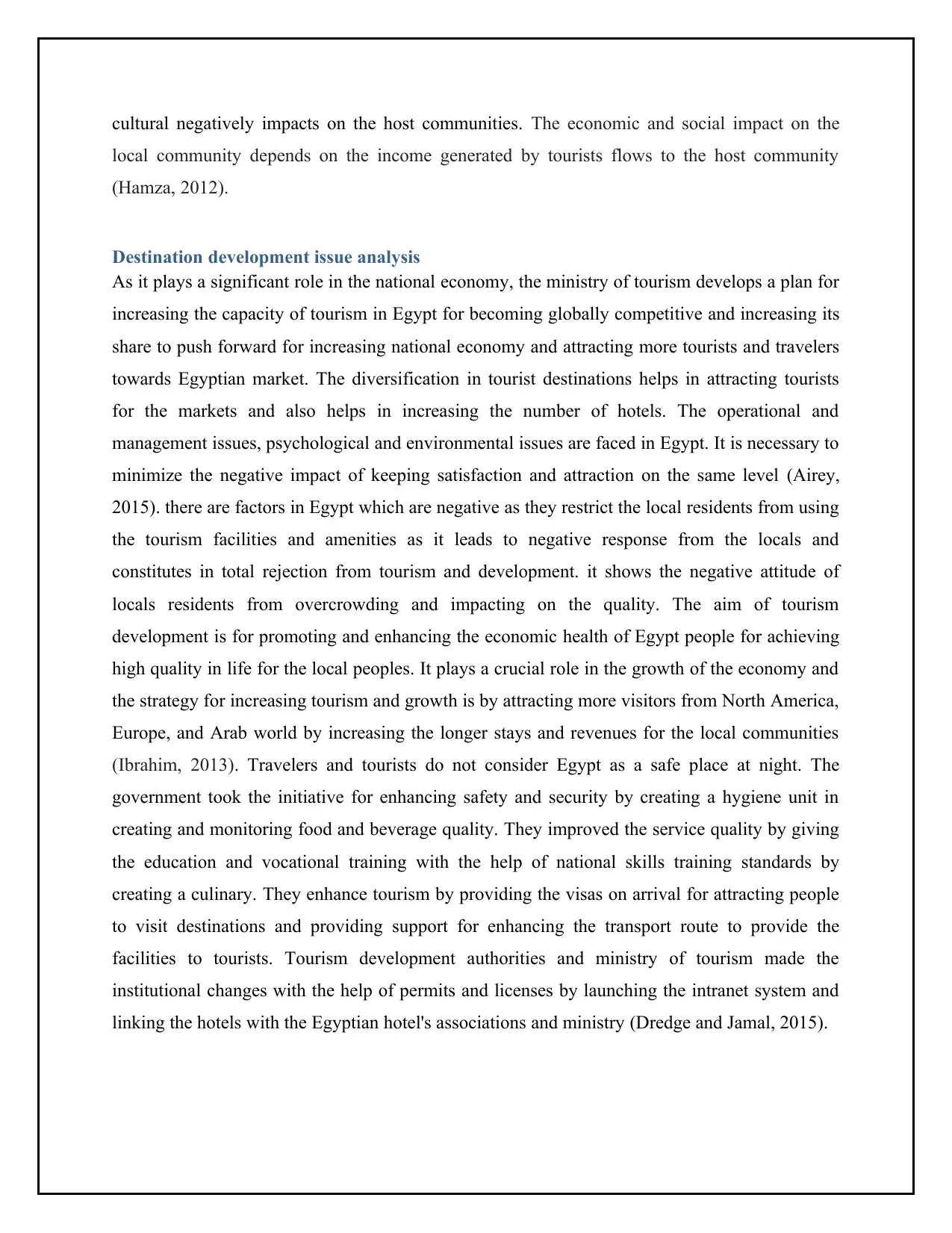
cultural negatively impacts on the host communities. The economic and social impact on the
local community depends on the income generated by tourists flows to the host community
(Hamza, 2012).
Destination development issue analysis
As it plays a significant role in the national economy, the ministry of tourism develops a plan for
increasing the capacity of tourism in Egypt for becoming globally competitive and increasing its
share to push forward for increasing national economy and attracting more tourists and travelers
towards Egyptian market. The diversification in tourist destinations helps in attracting tourists
for the markets and also helps in increasing the number of hotels. The operational and
management issues, psychological and environmental issues are faced in Egypt. It is necessary to
minimize the negative impact of keeping satisfaction and attraction on the same level (Airey,
2015). there are factors in Egypt which are negative as they restrict the local residents from using
the tourism facilities and amenities as it leads to negative response from the locals and
constitutes in total rejection from tourism and development. it shows the negative attitude of
locals residents from overcrowding and impacting on the quality. The aim of tourism
development is for promoting and enhancing the economic health of Egypt people for achieving
high quality in life for the local peoples. It plays a crucial role in the growth of the economy and
the strategy for increasing tourism and growth is by attracting more visitors from North America,
Europe, and Arab world by increasing the longer stays and revenues for the local communities
(Ibrahim, 2013). Travelers and tourists do not consider Egypt as a safe place at night. The
government took the initiative for enhancing safety and security by creating a hygiene unit in
creating and monitoring food and beverage quality. They improved the service quality by giving
the education and vocational training with the help of national skills training standards by
creating a culinary. They enhance tourism by providing the visas on arrival for attracting people
to visit destinations and providing support for enhancing the transport route to provide the
facilities to tourists. Tourism development authorities and ministry of tourism made the
institutional changes with the help of permits and licenses by launching the intranet system and
linking the hotels with the Egyptian hotel's associations and ministry (Dredge and Jamal, 2015).
local community depends on the income generated by tourists flows to the host community
(Hamza, 2012).
Destination development issue analysis
As it plays a significant role in the national economy, the ministry of tourism develops a plan for
increasing the capacity of tourism in Egypt for becoming globally competitive and increasing its
share to push forward for increasing national economy and attracting more tourists and travelers
towards Egyptian market. The diversification in tourist destinations helps in attracting tourists
for the markets and also helps in increasing the number of hotels. The operational and
management issues, psychological and environmental issues are faced in Egypt. It is necessary to
minimize the negative impact of keeping satisfaction and attraction on the same level (Airey,
2015). there are factors in Egypt which are negative as they restrict the local residents from using
the tourism facilities and amenities as it leads to negative response from the locals and
constitutes in total rejection from tourism and development. it shows the negative attitude of
locals residents from overcrowding and impacting on the quality. The aim of tourism
development is for promoting and enhancing the economic health of Egypt people for achieving
high quality in life for the local peoples. It plays a crucial role in the growth of the economy and
the strategy for increasing tourism and growth is by attracting more visitors from North America,
Europe, and Arab world by increasing the longer stays and revenues for the local communities
(Ibrahim, 2013). Travelers and tourists do not consider Egypt as a safe place at night. The
government took the initiative for enhancing safety and security by creating a hygiene unit in
creating and monitoring food and beverage quality. They improved the service quality by giving
the education and vocational training with the help of national skills training standards by
creating a culinary. They enhance tourism by providing the visas on arrival for attracting people
to visit destinations and providing support for enhancing the transport route to provide the
facilities to tourists. Tourism development authorities and ministry of tourism made the
institutional changes with the help of permits and licenses by launching the intranet system and
linking the hotels with the Egyptian hotel's associations and ministry (Dredge and Jamal, 2015).
Paraphrase This Document
Need a fresh take? Get an instant paraphrase of this document with our AI Paraphraser
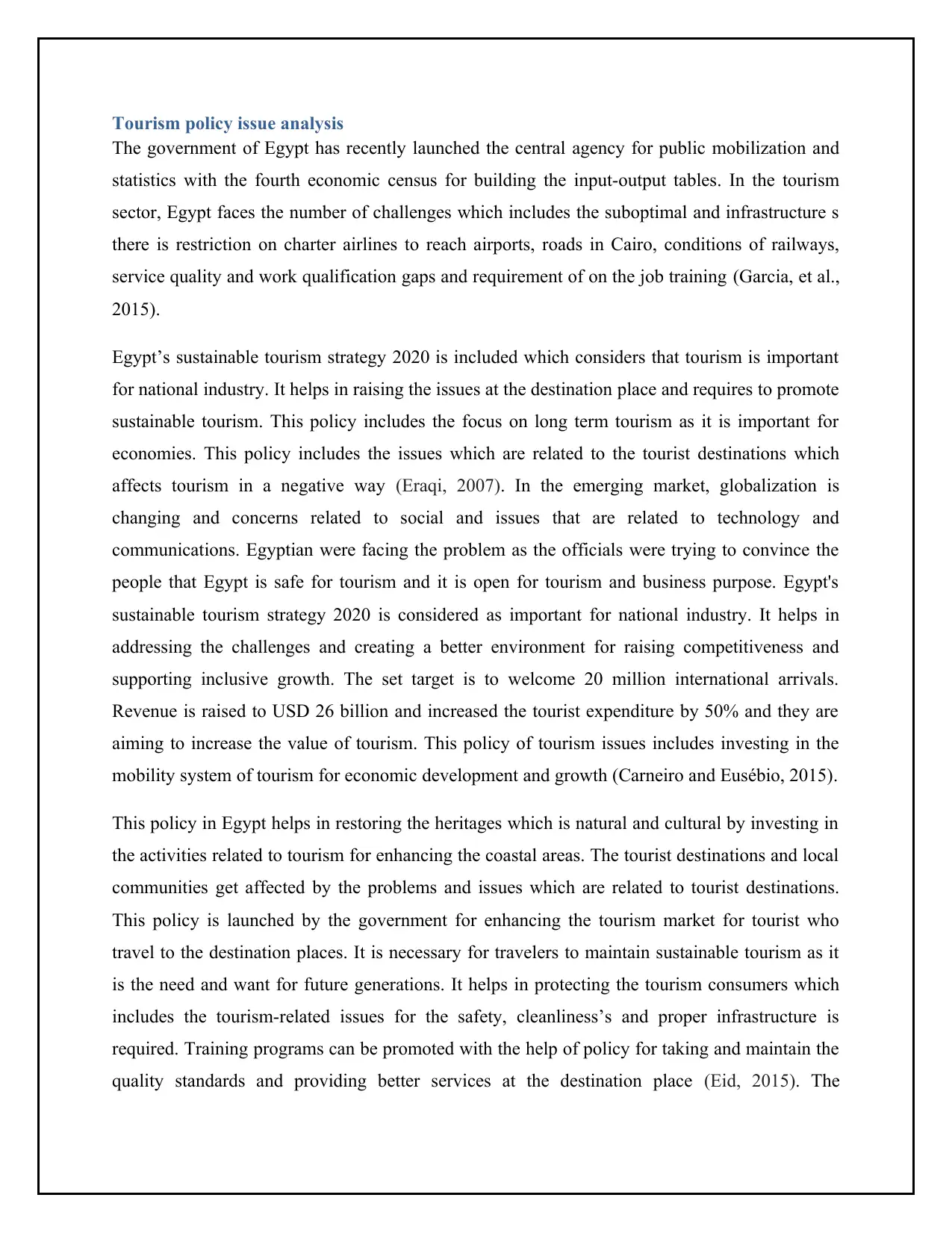
Tourism policy issue analysis
The government of Egypt has recently launched the central agency for public mobilization and
statistics with the fourth economic census for building the input-output tables. In the tourism
sector, Egypt faces the number of challenges which includes the suboptimal and infrastructure s
there is restriction on charter airlines to reach airports, roads in Cairo, conditions of railways,
service quality and work qualification gaps and requirement of on the job training (Garcia, et al.,
2015).
Egypt’s sustainable tourism strategy 2020 is included which considers that tourism is important
for national industry. It helps in raising the issues at the destination place and requires to promote
sustainable tourism. This policy includes the focus on long term tourism as it is important for
economies. This policy includes the issues which are related to the tourist destinations which
affects tourism in a negative way (Eraqi, 2007). In the emerging market, globalization is
changing and concerns related to social and issues that are related to technology and
communications. Egyptian were facing the problem as the officials were trying to convince the
people that Egypt is safe for tourism and it is open for tourism and business purpose. Egypt's
sustainable tourism strategy 2020 is considered as important for national industry. It helps in
addressing the challenges and creating a better environment for raising competitiveness and
supporting inclusive growth. The set target is to welcome 20 million international arrivals.
Revenue is raised to USD 26 billion and increased the tourist expenditure by 50% and they are
aiming to increase the value of tourism. This policy of tourism issues includes investing in the
mobility system of tourism for economic development and growth (Carneiro and Eusébio, 2015).
This policy in Egypt helps in restoring the heritages which is natural and cultural by investing in
the activities related to tourism for enhancing the coastal areas. The tourist destinations and local
communities get affected by the problems and issues which are related to tourist destinations.
This policy is launched by the government for enhancing the tourism market for tourist who
travel to the destination places. It is necessary for travelers to maintain sustainable tourism as it
is the need and want for future generations. It helps in protecting the tourism consumers which
includes the tourism-related issues for the safety, cleanliness’s and proper infrastructure is
required. Training programs can be promoted with the help of policy for taking and maintain the
quality standards and providing better services at the destination place (Eid, 2015). The
The government of Egypt has recently launched the central agency for public mobilization and
statistics with the fourth economic census for building the input-output tables. In the tourism
sector, Egypt faces the number of challenges which includes the suboptimal and infrastructure s
there is restriction on charter airlines to reach airports, roads in Cairo, conditions of railways,
service quality and work qualification gaps and requirement of on the job training (Garcia, et al.,
2015).
Egypt’s sustainable tourism strategy 2020 is included which considers that tourism is important
for national industry. It helps in raising the issues at the destination place and requires to promote
sustainable tourism. This policy includes the focus on long term tourism as it is important for
economies. This policy includes the issues which are related to the tourist destinations which
affects tourism in a negative way (Eraqi, 2007). In the emerging market, globalization is
changing and concerns related to social and issues that are related to technology and
communications. Egyptian were facing the problem as the officials were trying to convince the
people that Egypt is safe for tourism and it is open for tourism and business purpose. Egypt's
sustainable tourism strategy 2020 is considered as important for national industry. It helps in
addressing the challenges and creating a better environment for raising competitiveness and
supporting inclusive growth. The set target is to welcome 20 million international arrivals.
Revenue is raised to USD 26 billion and increased the tourist expenditure by 50% and they are
aiming to increase the value of tourism. This policy of tourism issues includes investing in the
mobility system of tourism for economic development and growth (Carneiro and Eusébio, 2015).
This policy in Egypt helps in restoring the heritages which is natural and cultural by investing in
the activities related to tourism for enhancing the coastal areas. The tourist destinations and local
communities get affected by the problems and issues which are related to tourist destinations.
This policy is launched by the government for enhancing the tourism market for tourist who
travel to the destination places. It is necessary for travelers to maintain sustainable tourism as it
is the need and want for future generations. It helps in protecting the tourism consumers which
includes the tourism-related issues for the safety, cleanliness’s and proper infrastructure is
required. Training programs can be promoted with the help of policy for taking and maintain the
quality standards and providing better services at the destination place (Eid, 2015). The
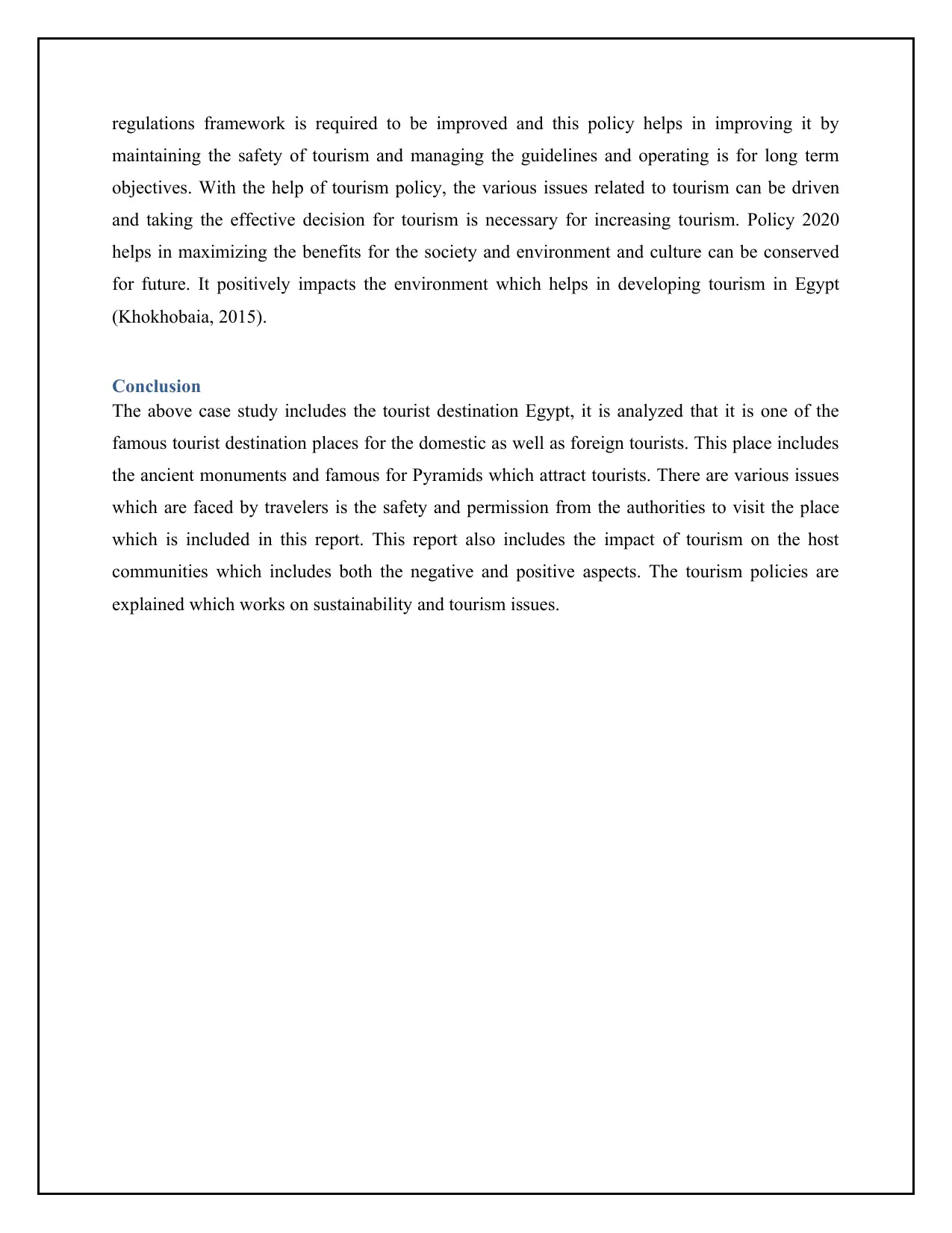
regulations framework is required to be improved and this policy helps in improving it by
maintaining the safety of tourism and managing the guidelines and operating is for long term
objectives. With the help of tourism policy, the various issues related to tourism can be driven
and taking the effective decision for tourism is necessary for increasing tourism. Policy 2020
helps in maximizing the benefits for the society and environment and culture can be conserved
for future. It positively impacts the environment which helps in developing tourism in Egypt
(Khokhobaia, 2015).
Conclusion
The above case study includes the tourist destination Egypt, it is analyzed that it is one of the
famous tourist destination places for the domestic as well as foreign tourists. This place includes
the ancient monuments and famous for Pyramids which attract tourists. There are various issues
which are faced by travelers is the safety and permission from the authorities to visit the place
which is included in this report. This report also includes the impact of tourism on the host
communities which includes both the negative and positive aspects. The tourism policies are
explained which works on sustainability and tourism issues.
maintaining the safety of tourism and managing the guidelines and operating is for long term
objectives. With the help of tourism policy, the various issues related to tourism can be driven
and taking the effective decision for tourism is necessary for increasing tourism. Policy 2020
helps in maximizing the benefits for the society and environment and culture can be conserved
for future. It positively impacts the environment which helps in developing tourism in Egypt
(Khokhobaia, 2015).
Conclusion
The above case study includes the tourist destination Egypt, it is analyzed that it is one of the
famous tourist destination places for the domestic as well as foreign tourists. This place includes
the ancient monuments and famous for Pyramids which attract tourists. There are various issues
which are faced by travelers is the safety and permission from the authorities to visit the place
which is included in this report. This report also includes the impact of tourism on the host
communities which includes both the negative and positive aspects. The tourism policies are
explained which works on sustainability and tourism issues.
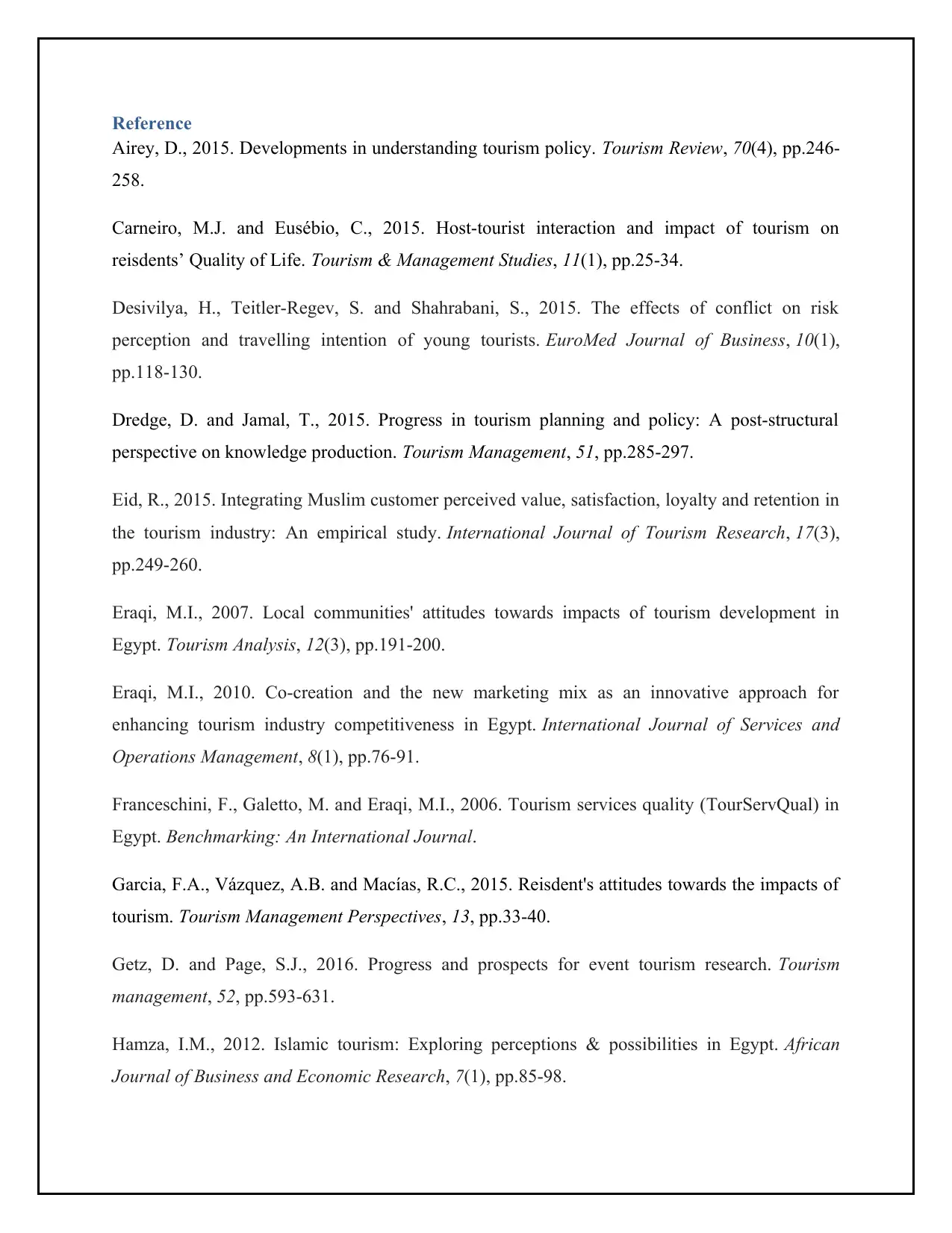
Reference
Airey, D., 2015. Developments in understanding tourism policy. Tourism Review, 70(4), pp.246-
258.
Carneiro, M.J. and Eusébio, C., 2015. Host-tourist interaction and impact of tourism on
reisdents’ Quality of Life. Tourism & Management Studies, 11(1), pp.25-34.
Desivilya, H., Teitler-Regev, S. and Shahrabani, S., 2015. The effects of conflict on risk
perception and travelling intention of young tourists. EuroMed Journal of Business, 10(1),
pp.118-130.
Dredge, D. and Jamal, T., 2015. Progress in tourism planning and policy: A post-structural
perspective on knowledge production. Tourism Management, 51, pp.285-297.
Eid, R., 2015. Integrating Muslim customer perceived value, satisfaction, loyalty and retention in
the tourism industry: An empirical study. International Journal of Tourism Research, 17(3),
pp.249-260.
Eraqi, M.I., 2007. Local communities' attitudes towards impacts of tourism development in
Egypt. Tourism Analysis, 12(3), pp.191-200.
Eraqi, M.I., 2010. Co-creation and the new marketing mix as an innovative approach for
enhancing tourism industry competitiveness in Egypt. International Journal of Services and
Operations Management, 8(1), pp.76-91.
Franceschini, F., Galetto, M. and Eraqi, M.I., 2006. Tourism services quality (TourServQual) in
Egypt. Benchmarking: An International Journal.
Garcia, F.A., Vázquez, A.B. and Macías, R.C., 2015. Reisdent's attitudes towards the impacts of
tourism. Tourism Management Perspectives, 13, pp.33-40.
Getz, D. and Page, S.J., 2016. Progress and prospects for event tourism research. Tourism
management, 52, pp.593-631.
Hamza, I.M., 2012. Islamic tourism: Exploring perceptions & possibilities in Egypt. African
Journal of Business and Economic Research, 7(1), pp.85-98.
Airey, D., 2015. Developments in understanding tourism policy. Tourism Review, 70(4), pp.246-
258.
Carneiro, M.J. and Eusébio, C., 2015. Host-tourist interaction and impact of tourism on
reisdents’ Quality of Life. Tourism & Management Studies, 11(1), pp.25-34.
Desivilya, H., Teitler-Regev, S. and Shahrabani, S., 2015. The effects of conflict on risk
perception and travelling intention of young tourists. EuroMed Journal of Business, 10(1),
pp.118-130.
Dredge, D. and Jamal, T., 2015. Progress in tourism planning and policy: A post-structural
perspective on knowledge production. Tourism Management, 51, pp.285-297.
Eid, R., 2015. Integrating Muslim customer perceived value, satisfaction, loyalty and retention in
the tourism industry: An empirical study. International Journal of Tourism Research, 17(3),
pp.249-260.
Eraqi, M.I., 2007. Local communities' attitudes towards impacts of tourism development in
Egypt. Tourism Analysis, 12(3), pp.191-200.
Eraqi, M.I., 2010. Co-creation and the new marketing mix as an innovative approach for
enhancing tourism industry competitiveness in Egypt. International Journal of Services and
Operations Management, 8(1), pp.76-91.
Franceschini, F., Galetto, M. and Eraqi, M.I., 2006. Tourism services quality (TourServQual) in
Egypt. Benchmarking: An International Journal.
Garcia, F.A., Vázquez, A.B. and Macías, R.C., 2015. Reisdent's attitudes towards the impacts of
tourism. Tourism Management Perspectives, 13, pp.33-40.
Getz, D. and Page, S.J., 2016. Progress and prospects for event tourism research. Tourism
management, 52, pp.593-631.
Hamza, I.M., 2012. Islamic tourism: Exploring perceptions & possibilities in Egypt. African
Journal of Business and Economic Research, 7(1), pp.85-98.
Secure Best Marks with AI Grader
Need help grading? Try our AI Grader for instant feedback on your assignments.
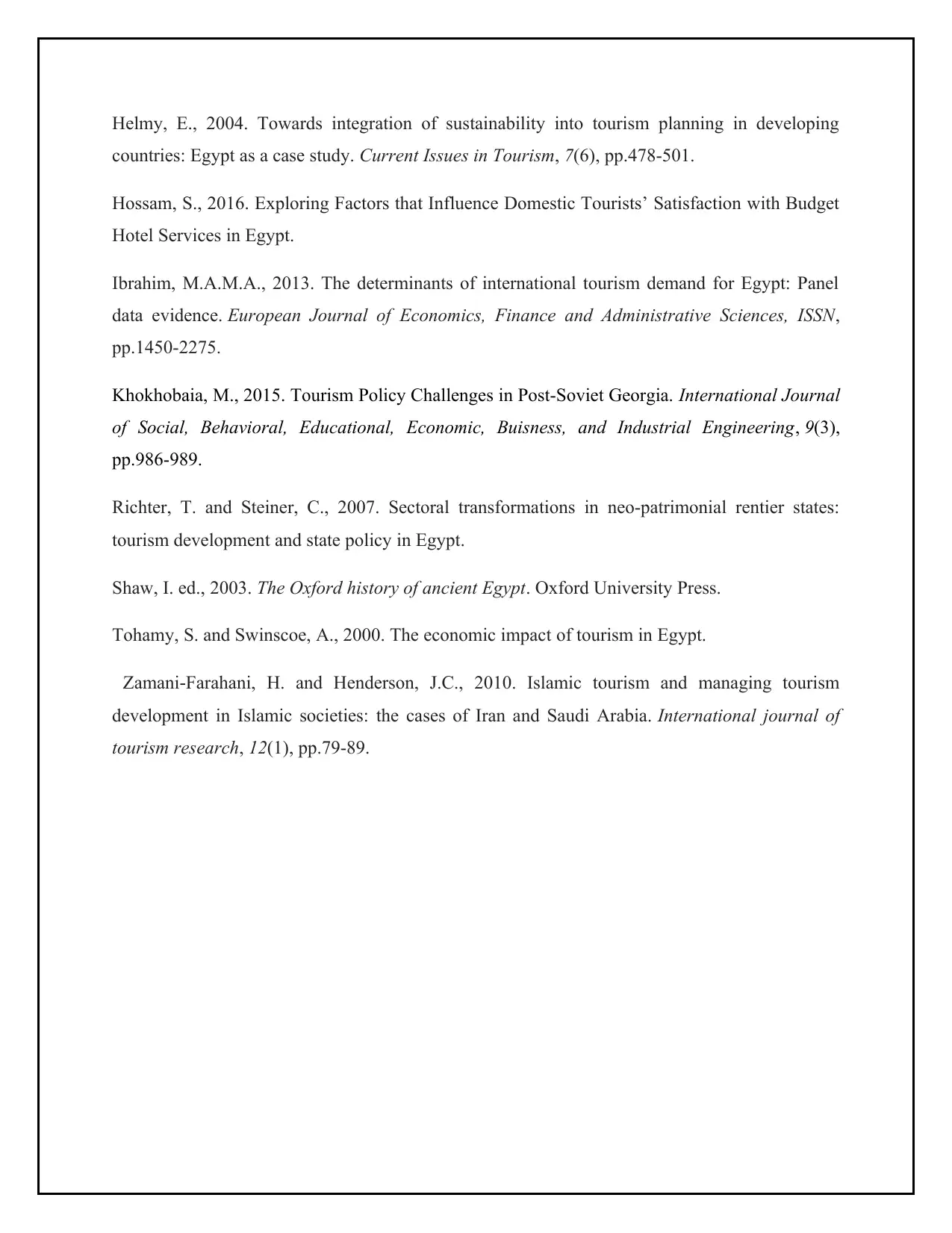
Helmy, E., 2004. Towards integration of sustainability into tourism planning in developing
countries: Egypt as a case study. Current Issues in Tourism, 7(6), pp.478-501.
Hossam, S., 2016. Exploring Factors that Influence Domestic Tourists’ Satisfaction with Budget
Hotel Services in Egypt.
Ibrahim, M.A.M.A., 2013. The determinants of international tourism demand for Egypt: Panel
data evidence. European Journal of Economics, Finance and Administrative Sciences, ISSN,
pp.1450-2275.
Khokhobaia, M., 2015. Tourism Policy Challenges in Post-Soviet Georgia. International Journal
of Social, Behavioral, Educational, Economic, Buisness, and Industrial Engineering, 9(3),
pp.986-989.
Richter, T. and Steiner, C., 2007. Sectoral transformations in neo-patrimonial rentier states:
tourism development and state policy in Egypt.
Shaw, I. ed., 2003. The Oxford history of ancient Egypt. Oxford University Press.
Tohamy, S. and Swinscoe, A., 2000. The economic impact of tourism in Egypt.
Zamani Farahani, H. and Henderson, J.C., 2010. Islamic tourism and managing tourism‐
development in Islamic societies: the cases of Iran and Saudi Arabia. International journal of
tourism research, 12(1), pp.79-89.
countries: Egypt as a case study. Current Issues in Tourism, 7(6), pp.478-501.
Hossam, S., 2016. Exploring Factors that Influence Domestic Tourists’ Satisfaction with Budget
Hotel Services in Egypt.
Ibrahim, M.A.M.A., 2013. The determinants of international tourism demand for Egypt: Panel
data evidence. European Journal of Economics, Finance and Administrative Sciences, ISSN,
pp.1450-2275.
Khokhobaia, M., 2015. Tourism Policy Challenges in Post-Soviet Georgia. International Journal
of Social, Behavioral, Educational, Economic, Buisness, and Industrial Engineering, 9(3),
pp.986-989.
Richter, T. and Steiner, C., 2007. Sectoral transformations in neo-patrimonial rentier states:
tourism development and state policy in Egypt.
Shaw, I. ed., 2003. The Oxford history of ancient Egypt. Oxford University Press.
Tohamy, S. and Swinscoe, A., 2000. The economic impact of tourism in Egypt.
Zamani Farahani, H. and Henderson, J.C., 2010. Islamic tourism and managing tourism‐
development in Islamic societies: the cases of Iran and Saudi Arabia. International journal of
tourism research, 12(1), pp.79-89.
1 out of 11
Your All-in-One AI-Powered Toolkit for Academic Success.
+13062052269
info@desklib.com
Available 24*7 on WhatsApp / Email
![[object Object]](/_next/static/media/star-bottom.7253800d.svg)
Unlock your academic potential
© 2024 | Zucol Services PVT LTD | All rights reserved.

